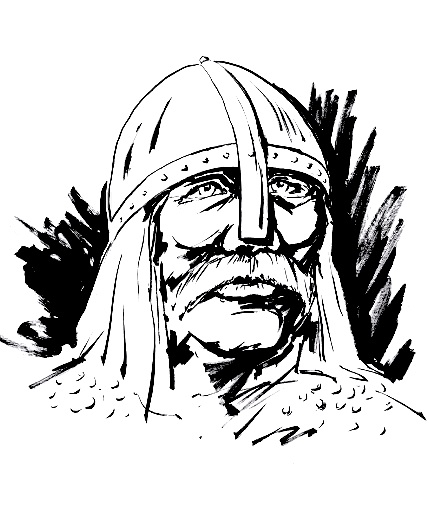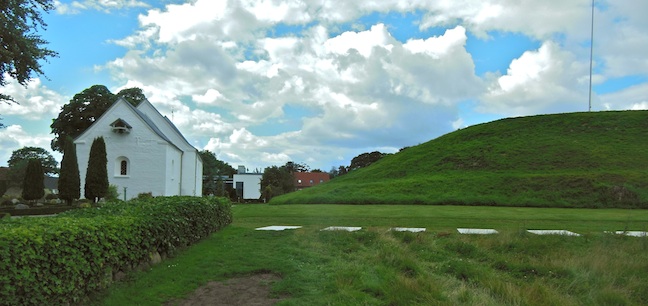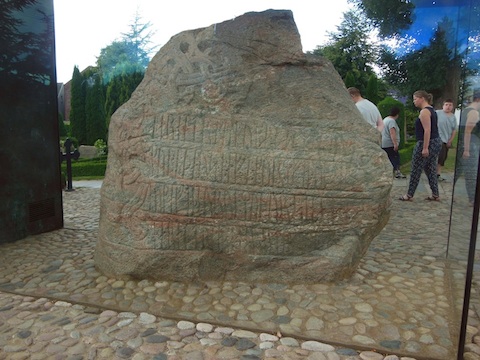The St. Brice Massacre near present day
Oxford was ordered by Aethelred "the unready" against the
Danish settlers, many were whom were previous Vikings.
Harald "Bluetooth" was very much a Viking in the present
use of the word. In about 976 he was threated by Emperor
Otta (Otto).
The Emperor Otta (Otto) was at this time in the Saxon
country, and sent a message to King Harald, the Danish
king, that he must take on the true faith and be baptized,
he and all his people whom he ruled; "otherwise," says the
emperor, "we will march against him with an army." The
Danish king ordered the land defence to be fitted out,
Danavirke (the Danish wall) to be well fortified, and his
ships of war rigged out. He sent a message also to
Earl Hakon in Norway to come to him early in spring, and
with as many men as he could possibly raise. In
spring (975) Earl Hakon levied an army over the whole
country which was very numerous, and with it he sailed to
meet the Danish king. The king received him in the
most honourable manner. Many other chiefs also
joined the Danish king with their men, so that he had
gathered a very large army.
Olaf Trygvason's
War Expedition
Olaf Trygvason had been all winter (982) in Vindland, as
before related, and went the same winter to the baronies
in Vindland which had formerly been under Queen Geira, but
had withdrawn themselves from obedience and payment of
taxes. There Olaf made war, killed many people,
burnt out others, took much property, and laid all of them
under subjection to him, and then went back to his castle.
Early in spring Olaf rigged out his ships and set off to
sea. He sailed to Skane and made a landing. The
people of the country assembled, and gave him battle; but
King Olaf conquere, an mad a great booty. He then
sailed eastward to the island of Gotland, where he
captured a merchant vessel belonging to the people of
Jamtaland. They mad a brave defence; but the end of
it was the Olaf cleared the deck, killed many of the men,
and took all the goods. He had a third battle in Gotland,
in which he also gained the victory, and made a great
booty. .....
Otta and Hakon in
Battle
The Emperor Otta assembled a great army from Saxland,
Frakland, Frisland, and Vindland. King Burizleif
followed him with a large army, and in it was his
son-in-law, Olaf Trygvason. The Emperor had a great
body of horsemen, and still greater of foot people, and a
great army from Holstein. Harald, the Danish king,
sent Erl Hakon with the army of Northmen that followed him
southwards to Danavirke, to defend his kingdom on theat
side. So it is told in "Vellekla:" ....
The Emperor Otta came with his
army from the south to Danavirke, but Earl Hakon defended
the rampart with his men. The Dane-work (Danavirke)
was constructed in this way: - Two fjords run into
the land one on each side; and in the farthest bight of
these fjords the Danes had made a great wall of stone
turf, and timber, and dug a deep and broad ditch in front
of it, and had also built a castle over each gate of
it. There was a hard battle there, of which the
"Vellekla" speaks
"Thick the storm of arrows flew,
Loud was the din, black was the view
Of close array of shield and spear
Of Vind, and Frank, and Saxon there. |
But little wrecked our gallant men;
And loud the cry might be heard then
Of Norway's brave sea-roving son ---
"On 'gainst the foe! on ! lead us on!" |
Earl Hakon drew up his people in ranks
upon all the gate-towers of the wall, but the greater part
of them he kept marching along the wall to make a defence
wheresoever an attack was threatened. Many of the
emperor's people fell with making any impression on the
fortification, so the emperor turned back without further
attempt at an assault on it. So it is said in the
"Velleka":
After this battle
Earl Hakon went back to his ships, and intended to sail
home to Norway; but he did not get a favourable wind, and
lay for some time outside at Limafjord.
Harald and
Hakon are baptized.
The Emperor Otta turned back with his
troops to Slesvik, collected his ships of war, and crossed
the fjord of Sle into Jutland. As soon as the Danish
king heard of this he marched his army against him and
there was a battle, in which the emperor at last got the
victory. The Danish king fled to Limafjord and took
refuge in the island Marsey. By the help of
mediators who went between the king and the emperor, a
truce and a meeting between them were agreed on. The
Emperor Otta and the Danish king met upon Marsey.
There Bishop Poppo instructed King Harald in the holy
faith; he bore red hot irons in his hands, and exhibited
his unscorched hands to the king. Thereafter King
Harald allowed himself to be baptized, and also the whole
Danish army. King Harald, while he was in Marsey, had sent
a message to Hakon that he should come to his succour; and
the earl had just reach the island when the king had
received baptism. The king sends word to the earl to
come to him, and when they met the king forced the earl to
allow himself also to be baptized. So Earl Hakon and
all the men who were with him were baptized; the king gave
them priest and other learned men with them, and ordered
that the earl should make all the people in Norway be
baptized. On that they separated; and the earl went out to
sea, there wait for wind. [Anderson (Laing).
145-155]






